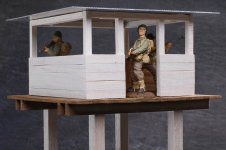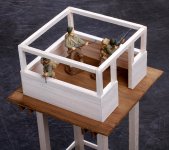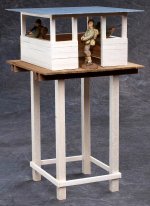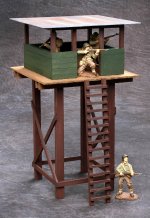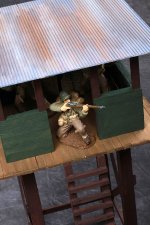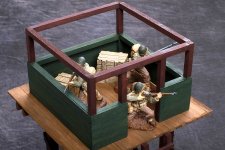Hi Lads, yes a dingo I am, born and bred in the Sunshine state...

thanks for the kind words, Ladder almost finished... will post more in the near future....
all the best,
marc
An ellipsis is a series of three points with spaces between them (. . .) inserted into a quotation to indicate the omission of material from the original quotation. There are quite a few simple rules for the proper use of ellipses, which are used more often in legal writing than most forms of writing, since lawyers often (generally too often) quote material from other sources. Failure to use the proper form of an ellipsis could misrepresent the work of another person and result in legal liability for the writer. Correct use of ellipses, on the other hand, shows that the writer has carefully attended to detail, and thus increases the reader's confidence in the reliability of the written work.
1. When placing an ellipsis in the middle of a quotation to indicate the omission of material, use three points with spaces before and after the ellipsis.
Incorrect: The First Amendment provides that "Congress shall make no law respecting. . .the right of the people peaceably to assemble, and to petition the Government for a redress of grievances." U.S. Const. amend. I.
Correct: The First Amendment provides that "Congress shall make no law respecting . . . the right of the people peaceably to assemble, and to petition the Government for a redress of grievances." U.S. Const. amend. I.
2. When placing an ellipsis at the end of a quotation to indicate the omission of material, use four points -- a three-point ellipsis and a period. The ellipsis should follow a blank space.
Incorrect: The First Amendment provides that "Congress shall make no law. . . abridging the freedom of speech. . ." U.S. Const. amend. I.
Correct: The First Amendment provides that "Congress shall make no law . . . abridging the freedom of speech . . . ." U.S. Const. amend. I.
3. Do not place an ellipsis at the beginning of a quotation to indicate the omission of material.
Incorrect: The First Amendment also prohibits laws ". . . respecting an establishment of religion. . . ." U.S. Const. amend. I.
Correct: The First Amendment also prohibits laws "respecting an establishment of religion . . . ." U.S. Const. amend. I.
4. When combining a fully quoted sentence with a partially quoted sentence, or with a second, but nonconsecutive quoted sentence, place a period at the end of the fully quoted sentence, followed by a space, an ellipsis, another space, and the remainder of the quoted material. Do not place a space before a period at the end of a fully quoted sentence.
Incorrect: In a unanimous decision, Justice Holmes wrote, "The question in every case is whether the words used are used in such circumstances and are of such a nature as to create a clear and present danger that they will bring about the substantive evils that Congress has a right to prevent . . . .When a nation is at war many things that might be said in time of peace are such a hindrance to its effort that their utterance will not be endured so long as men fight and that no Court could regard them as protected by any constitutional right." Schenck v. United States, 249 U.S. 47, 52 (1919).
Correct: In a unanimous decision, Justice Holmes wrote, "The question in every case is whether the words used are used in such circumstances and are of such a nature as to create a clear and present danger that they will bring about the substantive evils that Congress has a right to prevent. . . . When a nation is at war many things that might be said in time of peace are such a hindrance to its effort that their utterance will not be endured so long as men fight and that no Court could regard them as protected by any constitutional right." Schenck v. United States, 249 U.S. 47, 52 (1919).
In the preceding series of quotations, the ellipsis in the middle of the two quotations indicates that one or more entire intervening sentences have been omitted.
Incorrect: In a unanimous decision, Justice Holmes wrote, "The question in every case is whether the words used are used in such circumstances and are of such a nature as to create a clear and present danger that they will bring about the substantive evils that Congress has a right to prevent. . . .their utterance will not be endured so long as men fight and that no Court could regard them as protected by any constitutional right." Schenck v. United States, 249 U.S. 47, 52 (1919).
Correct: In a unanimous decision, Justice Holmes wrote, "The question in every case is whether the words used are used in such circumstances and are of such a nature as to create a clear and present danger that they will bring about the substantive evils that Congress has a right to prevent. . . . [T]heir utterance will not be endured so long as men fight and that no Court could regard them as protected by any constitutional right." Schenck v. United States, 249 U.S. 47, 52 (1919).
In the preceding example, the ellipsis indicates that some material -- it could be a whole sentence and the beginning of the next sentence, or just the beginning of the next sentence -- has been omitted in the midst of the quoted material. The brackets around the "T" indicate that the letter was lower case in the original and was changed to upper case by the writer to create a proper sentence. The brackets also confirm that material at the start of the second quoted sentence was omitted, because the letter "T" would have been capitalized in the original, and therefore would require no brackets, if it had started a sentence. For more information concerning the use of brackets, see the section of this tutorial on brackets.
5. When omitting one or more entire paragraphs, indicate the omission by indenting four points and placing them on a separate line. If the quoted material is 50 words or more, use indented margins and do not use any quotation marks.
Incorrect:
"Poverty imposes costs on the nonpoor that warrant, on strictly economic grounds and without regard to ethical or political considerations, incurring some costs to reduce it. For example, poverty in the midst of a generally wealthy society is likely to increase the incidence of crime: the forgone income of a legitimate alternative occupation is low for someone who has little earning capacity in legitimate occupations, while the proximity of wealth increases the expected return from crime, or, stated another way, the cost of honesty. . . . An individual who feels endangered or appalled at the poverty around him can contribute to an organization designed to alleviate that poverty an amount equal to the benefit that he would derive from the reduction of poverty enabled by his contribution (net of administrative costs)." Richard A. Posner, Economic Analysis of Law 350 (2d ed. 1977).
Correct:
Poverty imposes costs on the nonpoor that warrant, on strictly economic grounds and without regard to ethical or political considerations, incurring some costs to reduce it. For example, poverty in the midst of a generally wealthy society is likely to increase the incidence of crime: the forgone income of a legitimate alternative occupation is low for someone who has little earning capacity in legitimate occupations, while the proximity of wealth increases the expected return from crime, or, stated another way, the cost of honesty.
. . . .
An individual who feels endangered or appalled at the poverty around him can contribute to an organization designed to alleviate that poverty an amount equal to the benefit that he would derive from the reduction of poverty enabled by his contribution (net of administrative costs).
Richard A. Posner, Economic Analysis of Law 350 (2d ed. 1977).
6. Never leave a point in an ellipsis floating at the beginning or end of a line of text. (However, you may have a period at the end of a fully quoted sentence at the end of a line of text and begin the ellipsis on the next line.)
Incorrect: "His refusal to cooperate with the court and name the source .
. . resulted in a contempt citation."
Also Incorrect:
"His refusal to cooperate with the court and name the source . .
. resulted in a contempt citation."
Correct: "His refusal to cooperate with the court and name the source . . .
resulted in a contempt citation."
Also Correct:
"His refusal to cooperate with the court and name the source
. . . resulted in a contempt citation."
Also Correct:
"The period may properly be placed at the end of a sentence.
. . . The ellipsis may then be placed on the following line, indicating the omission of an intervening sentence."


